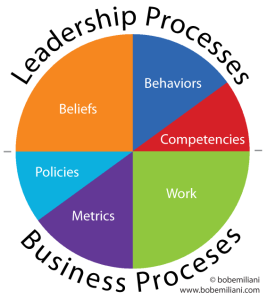What does it mean to lead with respect? Is it simply a matter of embracing a handful of new behavioral practices? That is where everyone starts out in their quest to understand and practice Real Lean. I did as well, more than 20 years ago. So did the Scientific Management people 85 years ago. But soon, you will discover, as everyone eventually does, that new behaviors, though seemingly full of promise, will not take you very far. The fact that we have so few capable Lean leaders bears testament to the limited impact of changing one’s behaviors. And, the “Respect for People” principle must never be reduced to a Lean tool, as this will do more harm than good.
A great deal of additional research, thought, and analysis must applied to uncover what exists beyond a few observable leadership behaviors. There are numerous details, nuances, and interrelationships that exist below the surface that go into making capable Lean leaders. These include critically important economic, social, and political beliefs about business that differ greatly between conventional leaders and Lean leaders.
 The image at right shows that leading people in ways that respect them and their interests includes much more than leaders’ behaviors. It encompasses leadership processes, of which behaviors is a part, and business processes. Behaviors is but one of six major elements that must be improved to lead people in ways that are consistent with Lean principles and practices.
The image at right shows that leading people in ways that respect them and their interests includes much more than leaders’ behaviors. It encompasses leadership processes, of which behaviors is a part, and business processes. Behaviors is but one of six major elements that must be improved to lead people in ways that are consistent with Lean principles and practices.
To focus solely on behaviors is akin to knowing how to play only seven songs on the piano by rote, and therefore never understanding music or the piano. Some effort is required, but it certainly is at best a minor challenge.
Leading Lean organizations require much more than the practice of rote behaviors – behaving in certain ways because its the right thing to do. Everything must change when conventional leadership and management routines are replaced with Lean leadership and management. Here are some examples:
Beliefs
- Outcomes involving key stakeholders must be non-zero-sum (win-win)
- Participating in kaizen to change beliefs
- Recognizing organizational politics as waste and which blocks material and information flows
- Treating all stakeholders fairly (employees, suppliers, customer, investors, and communities)
- Sharing the wealth with stakeholders; mutual benefits and mutual prosperity
Behaviors
- Not taking shortcuts to get quick results
- Not misleading people with bad information
- Testing your beliefs and assumptions
- Avoiding illogical thinking and decision-making traps
- Eliminating flavor-of-the-month reaction to fix deep-rooted problems
Competencies
- Making very few errors, and the impact of errors is small
- Doing research to get the facts
- Participating in kaizen to develop competencies
- Continuously improving one’s self and one’s capabilities through daily practice
- Teach others what you have learned
Work
- Not favoring one business function over another (e.g. finance over HR)
- Improving all processes, all the time, using human creativity
- Daily personal and process improvement
- Striving to achieve flow in all work activities
Metrics
- Eliminating all anti-Lean metrics
- Reducing number of metrics
- Simplifying all metrics
- De-emphasizing traditional metrics (that must be kept) in decision-making
Policies
- No layoffs due to Lean
- No blame
- Combining and eliminating policies
- Aligning all policies with Lean principles and practices
- Mistake-proofing policies
Take if from me – someone who has worked on this problem longer than anyone else – comprehending Lean leadership at the level of behaviors is only the beginning. You must move beyond that to fully comprehend time and information flow as the core functions of leadership.
Complete descriptions of what Lean leaders need to know and do can be found in my books Practical Lean Leadership where you will learn about leadership beliefs, behaviors, and competencies, Speed Leadership where you will learn about leadership processes, leadership process errors, and how to correct them, and Moving Forward Faster where you will the learn the economic, social, and political beliefs that go into making great Lean leaders. Start with these three fact-based, non-fiction books. You will find additional important details in my books REAL LEAN and in Lean Is Not Mean.
Click here to learn more about these fine Lean leadership books and what it takes to truly succeed as a Lean leader.
